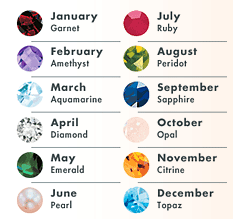|
| Bookmark this site |
| Search |
| Shop By Category |
| Cubic Zirconia Jewelry (43) Gemstone Bracelets (114) Gemstone Earrings (1982) Gemstone Necklaces (1405) Gemstone Rings (713) Gold Chains (13) Jewelry Boxes (4) Sterling Silver Jewelry (271) *All items are available in White Gold |
| Shop by Birthstones |
|
| Customer Service |
|
Testimonials Newsletter Tell A Friend FAQ Short Survey
|
| Jewelry Education |
| All about Diamonds All about Gemstones All about Gold Find your Ring Size Jewelry Measurements Jewelry Terms Articles |
ALL OF OUR JEWELRY IS MADE IN THE USA |
Diamond Education
|
The Diamond is the birthstone of April and the anniversary gemstone for the 10th and 60th years of marriage. Diamonds were discovered in India in 500 B.C., and the name "diamond" comes from the Greek word "Adamas" which means unconquerable - suggesting the eternity of love. Since ancient Greece, diamonds and diamond jewelry have been the traditional symbol of love, and the ancients believed they were hardened dew drops, splinters from the stars or crystallized lightning. A diamond is the hardest substance known to humankind, and is made of a crystallized carbon that has unique powers of light reflection. Since diamonds are composed of a single element, they are the purest of all gemstones. |
| The Structure of a Diamond |
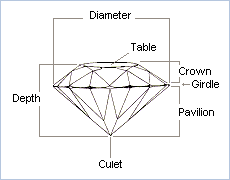 |
Proportion refers to the angles and relative measurements of a polished diamond. More than any other feature, proportions determine a diamond's optical properties. Studies have shown that table size, crown angle, and pavilion depth have a dramatic effect on a diamond's appearance. Symmetry is a grading term for the exactness of shape and placement of facets. Variations in symmetry include off-center culets and tables, poor facet alignment, misshapen facets, out-of-round girdles, and wavy girdles. |
Reflection |
Refraction |
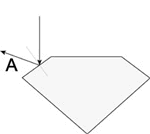 |
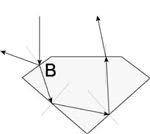 |
A) When a ray of light touches the surface of a diamond, part of the light is reflected back, this is external reflection. |
B) The rest of the ray penetrates the stone and is then reflected toward the center of the diamond. This is known as refraction. |
| The Value of a Diamond: The Four C's |
| Shape (Cut) |
 |
The Cut is the factor that determines the brilliance of a diamond. A classic round brilliant cut diamond has 58 facets : 33 on the top, 24 on the bottom, and the culet (1 point at the bottom). Each of the diamond's facets must be placed in exact geometric relation to one another when the stone is being cut. Quality diamonds must be properly cut and not "spread", which means that the proper proportions are compromised to make the diamond weigh more. |
| Clarity |
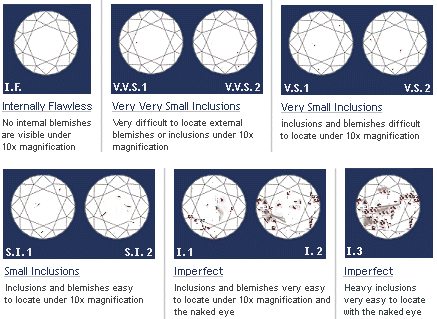 |
The Clarity of a diamond is based on the number, location, size, and type of inclusions found in the stone. An inclusion is an imperfection or trace mineral in the stone that is visible under the magnification of a jeweler's loupe. The fewer inclusions the diamond has; the clearer, more brilliant and more expensive the diamond will be. A "Flawless" diamond is one that has no inclusions and is extremely rare and valuable. |
| Color |
 |
Colorless and near-colorless diamonds are the most valuable. Though most diamonds may appear colorless to the naked eye, the majority of diamonds contain slight traces of yellow or light brown when viewed under a jeweler's loupe. Depending on the stone's size, a single increase in color grade can boost the value of a diamond by thousands of dollars per carat. A traditional engagement diamond is usually colorless or near-colorless. |
|
|
|
The carat weight alone is almost meaningless unless you also consider the cut, clarity and color of the diamond. A large diamond is not very valuable if it lacks brilliance, purity and high-grade color. However, since larger stones are rarer than smaller ones, diamond value rises exponentially with carat weight. Therefore, a diamond weighing 3.0 carats, will always be worth more than three 1.0 carat stones of the same quality. No two diamonds are exactly alike, and you must weigh all of the factors - color, cut, clarity and carat weight - when making your diamond jewelry buying decision. |
| Home | | | Sitemap | | | News | | | Contact Us | | | Policies | | | Shipping Policy | | | Links |
